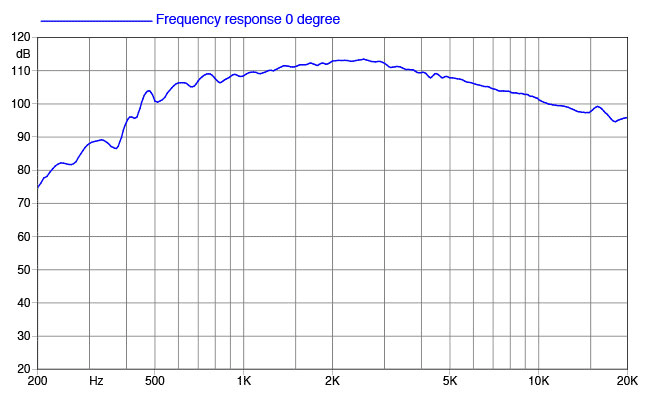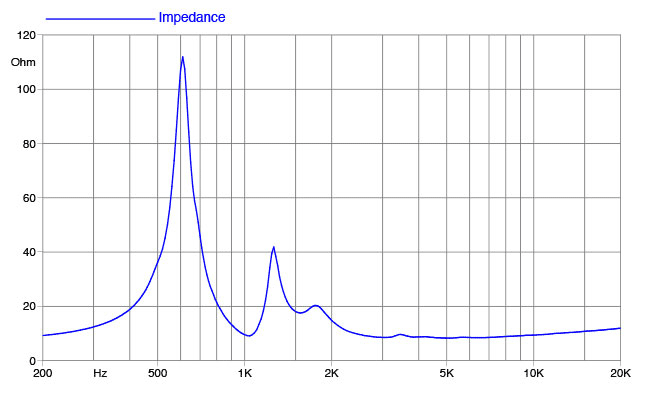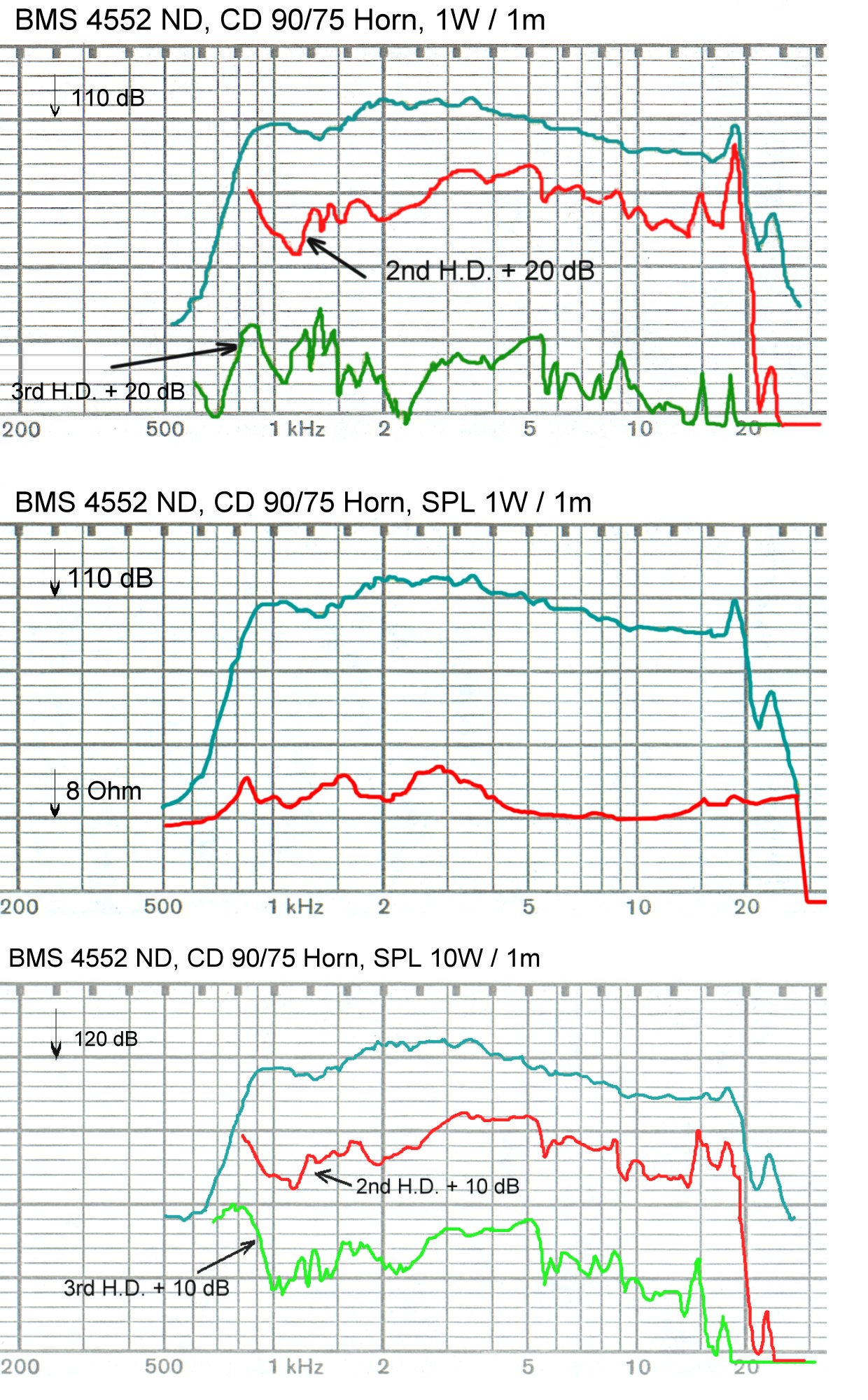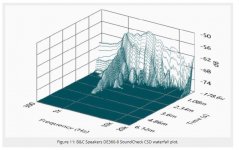And what type of horn or waveguides will work on the 1.4" exit with a range of 500hz-20kh. I do not think it will just sound good on any current 1.4" horn or wg.
Most 1.4" exits go to about 15-18kHz.
Good enough for what these things are made for; high performance, high SPL solutions.
It's only going to be a bit of a challenge to get a good working horn that goes down to 300Hz without any major problems effecting the higher frequencies.
My first guess would be more like a multi cell or similar construction.
Good enough for what these things are made for; high performance, high SPL solutions.
It's only going to be a bit of a challenge to get a good working horn that goes down to 300Hz without any major problems effecting the higher frequencies.
My first guess would be more like a multi cell or similar construction.
You'll probably want something like the K402, or a diffraction horn such as the Celestion 90x45 horn.
Another hijacker that looks very promising...




QUICK ACOUSTIC SPECS
Nominal Impedance: 8 Ohm
Minimum Impedance: 8.3 Ohm
AES Power above 0.9 kHz: 120 W
Maximum Power above 0.9 kHz: 240 W
Minimum Crossover Frequency: 0.7 kHz
Sensitivity (1W/1m): 109 dB
Frequency Range: 0.5÷20 kHz
Voice Coil Diameter: 86 mm (3.4 in)
Diaphragm Material: Ketone Polymer
Diaphragm Shape: Annular
Flux Density: 2.2 T
Re: 6.8 Ohm
Phase Plug Design: Radial




QUICK ACOUSTIC SPECS
Nominal Impedance: 8 Ohm
Minimum Impedance: 8.3 Ohm
AES Power above 0.9 kHz: 120 W
Maximum Power above 0.9 kHz: 240 W
Minimum Crossover Frequency: 0.7 kHz
Sensitivity (1W/1m): 109 dB
Frequency Range: 0.5÷20 kHz
Voice Coil Diameter: 86 mm (3.4 in)
Diaphragm Material: Ketone Polymer
Diaphragm Shape: Annular
Flux Density: 2.2 T
Re: 6.8 Ohm
Phase Plug Design: Radial
Re: the Faital HF1440
Can this really be a good driver for use on a constant directivity horn?
It's down to 100db/1W at 10kHz on the tractrix horn used for testing. Even with its massive power handling, after the necessary EQ it seems like it would be nowhere as loud as a garden variety compression driver. Or am I missing something?
Can this really be a good driver for use on a constant directivity horn?
It's down to 100db/1W at 10kHz on the tractrix horn used for testing. Even with its massive power handling, after the necessary EQ it seems like it would be nowhere as loud as a garden variety compression driver. Or am I missing something?
That's a valid observation. Here's a BMS 4552 for comparison:

We're dealing with the "Magic Triangle" of compression drivers:
1) you can make it affordable
2) you can make it efficient
3) you can give it a wide bandwidth
pick two.
There's an interesting new family of compression drivers from B&C, BMS and JBL that use unusually small throats, and it seems to increase the SPL above 10Khz. For instance, the BMS 4538HE produces something like 110dB at 20khz with one watt!
Whenever I'm building a speaker, the tweeter usually ends up being the weak link for me. So I'm eager to me dated with a set of these.
Unfortunately, there's still no free lunch. Power handling is just 25 watts. But the BMS produces more output above 10khz with 25 watts than the Faital does with a hundred. Of course, the Faital plays lower though.
Decisions, decisions.

We're dealing with the "Magic Triangle" of compression drivers:
1) you can make it affordable
2) you can make it efficient
3) you can give it a wide bandwidth
pick two.
There's an interesting new family of compression drivers from B&C, BMS and JBL that use unusually small throats, and it seems to increase the SPL above 10Khz. For instance, the BMS 4538HE produces something like 110dB at 20khz with one watt!
Whenever I'm building a speaker, the tweeter usually ends up being the weak link for me. So I'm eager to me dated with a set of these.
Unfortunately, there's still no free lunch. Power handling is just 25 watts. But the BMS produces more output above 10khz with 25 watts than the Faital does with a hundred. Of course, the Faital plays lower though.
Decisions, decisions.
Re: the Faital HF1440
Can this really be a good driver for use on a constant directivity horn?
It's down to 100db/1W at 10kHz on the tractrix horn used for testing. Even with its massive power handling, after the necessary EQ it seems like it would be nowhere as loud as a garden variety compression driver. Or am I missing something?
Not a big issues since there's not much music up there.
It might come into play at long distances as found at large outdoor festivals when hot dry temps are present. Though in those cases even the most efficient uhf driver will not totally or sometimes even partially make up for the losses .
Last edited:
Available from 400 EUR to 55555 RUB (it's about 750 EUR) 😀Any idea of what cost might be on these?
Any tests\measurments\listenings yet?
Last edited:
Does anyone know of any comparison with the BMS drivers yet? Primarly quality.
And secondly, am I correct to assume the B&C will be even more powerfull dB wise compared to the BMS? Not by a lot, but sensitivity looks to be a little bit better than the BMS 110dB (based on the graphs).
Maarten
And secondly, am I correct to assume the B&C will be even more powerfull dB wise compared to the BMS? Not by a lot, but sensitivity looks to be a little bit better than the BMS 110dB (based on the graphs).
Maarten
Ji Jzagaja,
I asked the people at B&C, and the exit angle is zero.
Best regards
Peter
I asked the people at B&C, and the exit angle is zero.
Best regards
Peter
Do we know dcx464 exit angle?
65mm is too big a voice coil for high frequency in a domestic audiophile setting. There will be diaphragm breakup well before 10kHz. That rules it out for me.
It’s tough to find a small format CD that has good extension, let alone a large format.
The B&C DCX464 65mm diaphragm is a ring radiator not a typical dome diaphragm like in a compression driver. The ring allows a larger voice coil on a diaphragm that has less surface area than the same diameter dome diaphragm. Less area less mass less mass equals more high frequency extension & better transients. As far as using these for a home audiophile setting i never would due to the word coaxial. That rules it out for me.
The B&C DCX464 65mm diaphragm is a ring radiator not a typical dome diaphragm like in a compression driver. The ring allows a larger voice coil on a diaphragm that has less surface area than the same diameter dome diaphragm. Less area less mass less mass equals more high frequency extension & better transients. As far as using these for a home audiophile setting i never would due to the word coaxial. That rules it out for me.
Yeah I see that now. The OP used the term “annular” so I was thinking tangerine phase plug like the Altec 802.
I prefer horn loaded planar or front horn loaded small fullrange for wide bandwidth IMHO.
Can you tell us what's the problem in a coaxial driver like this? What exactly makes it a less than ideal driver?The B&C DCX464 65mm diaphragm is a ring radiator not a typical dome diaphragm like in a compression driver. The ring allows a larger voice coil on a diaphragm that has less surface area than the same diameter dome diaphragm. Less area less mass less mass equals more high frequency extension & better transients. As far as using these for a home audiophile setting i never would due to the word coaxial. That rules it out for me.
Can you tell us what's the problem in a coaxial driver like this? What exactly makes it a less than ideal driver?
Since nobody is responding to you I'll take a shot at it. Since we don't know much about the B&C DCX464 I can look at something similar which is the BMS 4507ND. The problem has always been with the co-entrant design where the high and mid frequencies have to combine somehow without causing the high frequency wavefront to encounter an abrupt physical change in the pathway curvature. Usually the high frequency sound wave has to "jump" a physical gap. This causes higher order harmonics to form which effects the performance of the driver in the time domain. Evidence of this can be seen in a CSD waterfall plot of the BMS 4507ND compared against a regular compression driver such as the B&C DE360. As you can see the DE360 exhibits much better Spectral decay performance than the 4507ND.
I hope this helps!
The attached images were pulled from the following links...
Test Bench: BMS 4507ND Dual Diaphragm Coaxial Planar Wave Driver | audioXpress
Test Bench: B&C Speakers DE360-8 1” Exit Pro Sound Compression Driver | audioXpress
Attachments
Last edited:
Thank you!
I understand the issues with a normal coaxial driver but I had seen test results for the BMS unit.
I understand the issues with a normal coaxial driver but I had seen test results for the BMS unit.
The problem has always been with the co-entrant design where the high and mid frequencies have to combine somehow without causing the high frequency wavefront to encounter an abrupt physical change in the pathway curvature. Usually the high frequency sound wave has to "jump" a physical gap. This causes higher order harmonics to form which effects the performance of the driver in the time domain.
We have mitigated this with our (patent pending) midrange filter, which makes the MF path look very high impedance to the HF driver and filters the higher response of the MF driver so it doesn't resonate in the HF cavity.
FYI, these drivers should be available around the end of August in the US. Maybe sooner elsewhere. List price in the US is $1062.
We have mitigated this with our (patent pending) midrange filter, which makes the MF path look very high impedance to the HF driver and filters the higher response of the MF driver so it doesn't resonate in the HF cavity.
FYI, these drivers should be available around the end of August in the US. Maybe sooner elsewhere. List price in the US is $1062.
Wow that sounds interesting. What relation do you have with B&C? Do you know if AudioXpress will be doing a test review?
What relation do you have with B&C?
B&C Sales & Operations Director – North America
See B&C Speakers
- Home
- Loudspeakers
- Multi-Way
- B&C DCX464

